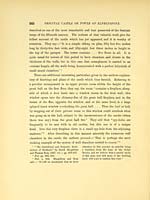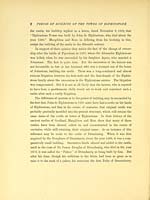Download files
Complete book:
Individual page:
Thumbnail gallery: Grid view | List view

ARMORIAL SHIELDS IN THE HALL OF ELPHINSTONE TOWER. \X
As throwing light on the antiquity of the castle, the same authors give
drawings of the armorial bearings which are carved in stone over the fire-
place of the great hall. 1 The shields are eight in number, and are neatly
engraved. The. two first shields are said to represent the Seton family
each having three crescents, two and one. The third shield is said to be
Maitland, the fourth Douglas, the fifth Menzies, the sixth Johnstone, the
seventh Elphinstone, and the eighth Maitland again.
The late Lord Elphinstone took a great interest in this ancient
tower, which was reacquired by his grandfather, the Honourable William
Fullerton Elphinstone of Carberry, after it had been out of the family, in
the hands of the Johnstones and other families, for centuries. The eminent
architects from whom we have quoted bear testimony to the great care
with which the castle is preserved. In the year 1871, after a visit paid to
the castle with his lordship, he sent me very careful pen-and-ink sketches
of these eight armorial shields, all drawn with his own hand. He was an
excellent draughtsman, and one of his friends once remarked to me that his
lordship's pen-and-ink sketches were as fine as steel engravings. These eight
sketches of the arms are still preserved, with his remarks upon several of
them. On Nos. 3 and 8 of the shields, which are assumed by the architects
to be those of Maitlands, Lord Elphinstone remarks — " But I can't make out
the dismemberment of the Maitland lion." His lordship says " No. 5 is
plain, but in the chief are marks as of two or three lions. It may be stars
or anything else, but I have drawn it as it appears." In a subsequent letter
his lordship wrote on 21st December 1871— "As for the Elphinstone Tower
shields, the place was out of the family so long, I suspect the shields had
reference to those in possession during the interregnum."
When the author of " The History of Tranent and its Surroundings '
applied to the late Lord Elphinstone for information as to the building of
1 "The Castellated and Domestic Architecture of Scotland," by David Macgibbon and
Thomas Ross, 1887, vol. i. p. 237.
VOL. I. b
As throwing light on the antiquity of the castle, the same authors give
drawings of the armorial bearings which are carved in stone over the fire-
place of the great hall. 1 The shields are eight in number, and are neatly
engraved. The. two first shields are said to represent the Seton family
each having three crescents, two and one. The third shield is said to be
Maitland, the fourth Douglas, the fifth Menzies, the sixth Johnstone, the
seventh Elphinstone, and the eighth Maitland again.
The late Lord Elphinstone took a great interest in this ancient
tower, which was reacquired by his grandfather, the Honourable William
Fullerton Elphinstone of Carberry, after it had been out of the family, in
the hands of the Johnstones and other families, for centuries. The eminent
architects from whom we have quoted bear testimony to the great care
with which the castle is preserved. In the year 1871, after a visit paid to
the castle with his lordship, he sent me very careful pen-and-ink sketches
of these eight armorial shields, all drawn with his own hand. He was an
excellent draughtsman, and one of his friends once remarked to me that his
lordship's pen-and-ink sketches were as fine as steel engravings. These eight
sketches of the arms are still preserved, with his remarks upon several of
them. On Nos. 3 and 8 of the shields, which are assumed by the architects
to be those of Maitlands, Lord Elphinstone remarks — " But I can't make out
the dismemberment of the Maitland lion." His lordship says " No. 5 is
plain, but in the chief are marks as of two or three lions. It may be stars
or anything else, but I have drawn it as it appears." In a subsequent letter
his lordship wrote on 21st December 1871— "As for the Elphinstone Tower
shields, the place was out of the family so long, I suspect the shields had
reference to those in possession during the interregnum."
When the author of " The History of Tranent and its Surroundings '
applied to the late Lord Elphinstone for information as to the building of
1 "The Castellated and Domestic Architecture of Scotland," by David Macgibbon and
Thomas Ross, 1887, vol. i. p. 237.
VOL. I. b
Set display mode to:
![]() Universal Viewer |
Universal Viewer | ![]() Mirador |
Large image | Transcription
Mirador |
Large image | Transcription
Images and transcriptions on this page, including medium image downloads, may be used under the Creative Commons Attribution 4.0 International Licence unless otherwise stated. ![]()
| Histories of Scottish families > Elphinstone family book of the Lords Elphinstone, Balmerino and Coupar > Memoirs > (25) Page ix |
|---|
| Permanent URL | https://digital.nls.uk/96559663 |
|---|
| Attribution and copyright: |
|
|---|
| Description | A selection of almost 400 printed items relating to the history of Scottish families, mostly dating from the 19th and early 20th centuries. Includes memoirs, genealogies and clan histories, with a few produced by emigrant families. The earliest family history goes back to AD 916. |
|---|

